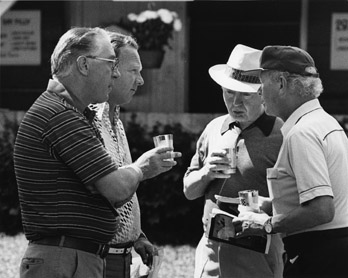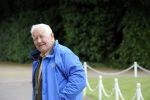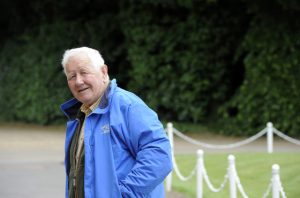Eleven years have passed since the Keeneland July Selected Yearling Sale was last conducted, but in no way has the legendary event been forgotten.
“I think it is best remembered by all those high-priced yearlings selling and just the glamour and the glory and the prestige of it,” said Tom Gentry, the Kentucky breeder and consignor who was famous for his A-list parties before the sale and other creative ways to entice prospective buyers.
From 1943 to 2002, the July Sale, known as the Summer Yearling Sale until 1987, was held on the grounds of the prestigious racecourse in Lexington, Kentucky. Keeneland selected yearlings for their pedigree and conformation, and the result was record-priced horses and a long list of global champions and major winners from all price ranges. The heyday occurred in the early 1980s, when Robert Sangster and Sheikh Mohammed locked horns over the progeny of Northern Dancer, whose colts and fillies were excelling in Classic races in Europe.
“The irresistible force of dogged determination met the immovable object of unlimited spending power at Keeneland on Tuesday night,” wrote Tony Morris in The Sporting Life in 1983 after Sheikh Mohammed outbid Sangster for a $10.2 million son of Northern Dancer colt who would be named Snaafi Dancer. The amount was nearly $6m above the previous record paid by Sangster a year earlier when he trumped Sheikh Mohammed for the sale-topping Nijinsky colt.
Leading the American advance at the time was trainer D Wayne Lukas, who chose yearlings and bid on them for a group of wealthy men that included Eugene V Klein, owner of the San Diego Chargers of the National Football League.
“You had this convergence of eight or ten people who really wanted to play at the highest level,” said Rogers Beasley, who served as Keeneland’s Director of Sales for 19 years from 1982 and is now Keeneland’s Vice-President of Racing. “At that time, America arguably had the best sires in the world. We had Northern Dancer, we had Nijinsky, Mr Prospector and, later on, Seattle Slew. We had Blushing Groom, Caro. You had a lot of interest from Europe in sires that stood over here.”
In July, some of the world’s wealthiest people arrived in Lexington in private planes that were parked side by side at Blue Grass Airport across the road from Keeneland, and they spent unbelievable amounts of money at the sale and around Lexington. Prominent consignors hosted dinners and parties to entertain prospective buyers. The entire show dazzled Lexington, and central Kentucky’s thoroughbred industry generated worldwide attention.
“People would just clog the sales pavilion on Monday and Tuesday nights [for the sale’s pre-eminent evening sessions held through 1984], knowing there was going to be excitement,” said Maryjean Wall, the former racing writer for the Lexington Herald-Leader. “You could just feel it in the air. It was definitely electric. You could not have not sensed it all over town.”
Sangster versus the sheikh
Sangster first appeared at the July sale in 1972 with trainer Vincent O’Brien and three years later paid $200,000 for the Northern Dancer colt The Minstrel. In 1977, The Minstrel became the English Horse of the Year and was syndicated for $9m, entering stud alongside his sire at Windfields Farm in Maryland. With John Magnier, Sangster and O’Brien would have great success with their plan to develop commercially profitable sires from their July purchases.
In 1980, Sheikh Mohammed, then aged 31, and his brothers were becoming more involved in thoroughbred racing, and they made their debut appearance at the July sale. The following year they arrived in Lexington in a Boeing 727 that was parked at the airport across from Keeneland’s entrance

Robert Sangster and Vincent O’Brien talk tactics at Keeneland
“We didn’t know where Dubai was, we didn’t know what Dubai was,” Wall said. “I will never forget this: the line of traffic that just slowed or stopped (so people could view the plane). We’d never seen in Lexington a plane with Arab script on the tail and flying this flag. We didn’t know what the Emirates flag was, and there it was. It didn’t take long for people in Lexington to figure out what it meant: it was big money at the horse sales.”
Sangster jokingly told Wall in 1981: “I think the Arabs were trying to intimidate us by parking their jet outside the Keeneland gate, but I had them fooled by moving in the Goodyear blimp in front of it.” With the blimp having made an unscheduled landing in Lexington due to bad weather, it was perfect timing for Sangster to take credit for its appearance. That year, BBA Ireland, agent for Sangster, outbid Sheikh Mohammed for the record $3.5m sale-topper, the Northern Dancer colt Ballydoyle, a full-brother to European champion and $1m Keeneland July purchase Storm Bird.
Just two years later, a sale record 33 yearlings brought $1m or more, and Sheikh Mohammed’s Aston Upthorpe Stud needed eight minutes to land Snaafi Dancer for $10.2m. The display board in the sales pavilion didn’t have enough digits to accommodate the amount.
“It was an occasion for praising the great god money, and never was worship displayed with more zealous fervour, concluding with a standing ovation which caused business to be temporarily suspended,” Morris wrote in The Sporting Life.
The amount was “a world record for irrationality,” said editor Kent Hollingsworth in The Blood-Horse, the weekly trade publication based in Lexington. Sports Illustrated, the weekly American all-sports magazine, turned the response by the colt’s breeder, Don Johnson of Crescent Farm, into the headline of Billy Reed’s article: “My God, Are These People Spending Real Money?”
In 1985, Lukas and his partners – not Sheikh Mohammed – challenged Sangster for the Nijinsky colt who was a half-brother to 1977 Triple Crown winner Seattle Slew and that year’s 2,000 Guineas winner Lomond. He was bred by Warner L Jones Jr, owner of Hermitage Farm, in partnership with Will Farish and WS Kilroy. The sales pavilion was packed in anticipation of the bidding battle.
“It was a circus atmosphere,” remembered Bill Landes, Jones’s right-hand man who remains with Hermitage as general manager. “You couldn’t breathe for all the people.”
“The bidding started at $1.25 million, quickly increased by increments of $500,000, and within one minute shot past $8 million,” wrote then-Keeneland President James E ‘Ted’ Bassett III and Bill Mooney in Keeneland’s Ted Bassett: My Life. “Once the bidding climbed beyond $9.8 million (which took only about another 40 seconds), only two groups remained in the battle.”
Sangster won when his man Joss Collins bid $100,000 more than the $13m that Lukas had offered. BBA England was listed as the buyer, representing Sangster, O’Brien, Magnier, Greek shipping magnate Stavros Niarchos and Los Angeles businessman Danny Schwartz. After the horse – Seattle Dancer – left the ring, the crowd recognised the accomplishment with applause for Jones, who acknowledged partners Farish and Kilroy.
The figure remains the world record for a yearling. It was surpassed as the highest amount ever paid for a thoroughbred in 2006 when Demi O’Byrne, agent for the Coolmore Stud partners, bought the Forestry colt The Green Monkey for $16m at the Fasig-Tipton February two-year-olds in training sale.
Sellers and celebrations
In the 1980s, the July Sale consignments included Hermitage, Gentry and Windfields Farm, along with Spendthrift Farm, Claiborne Farm, Nuckols Farm and North Ridge Farm of Kentucky. Spendthrift belonged to the powerful ‘Cousin’ Leslie Combs, “a garrulous showman with a faux southern gentleman surface charm,” wrote Edward L Bowen in Legacies of the Turf: A Century of Great Thoroughbred Breeders (Vol. 2).
“Leslie Combs was the consummate salesperson,” Beasley said. “He thought about selling horses 24-7, 365 days a year, and he was very good. He was always trying to find people [prospective buyers]. He’d go to California in the winter time; he’d be in Florida in the winter time at the parties where you had to be to meet people who might have an interest in horses, and he brought people into the game.”
Combs cultivated such wealthy owners as cosmetics queen Elizabeth Arden in the 1940s and heiress Dolly Green, who first appeared with him at the July Sale in 1980 when the “mystery woman” spent $2.2m on five yearlings. Among the horses Combs sold was the highest-priced July Sale filly, Alchaasibiyeh, a daughter of Seattle Slew purchased in 1984 by Sheikh Mohammed’s Darley Stud Management for $3.75m.
“He was the master salesman; I couldn’t compete with that,” Gentry said about Combs, whose parties inspired him to try to outdo his rival. “He had all the heavyweights, and basically they just bought from him. Then there was Warner Jones (chairman of Churchill Downs), who had a rapport with every trainer known to mankind. People would buy from him and wouldn’t buy from anybody else.
“Then there was little ol’ me with my 50-cent pencils and all that stuff,” said Gentry, who handed out promotional yardsticks, cigarette lighters, pens, watches, T-shirts and brown paper bags with liquor bottles (“It’ll help you out on a Sunday in Kentucky,” he said at the time when alcohol couldn’t legally be purchased on Sunday in the state).
During the carnival-themed party, guests rode an elephant, camel, Ferris wheel, merry-go-round and hot air balloon
“People loved the gifts,” he said. “They loved the attention. That party I gave I had the best entertainment. People would fight and die to get into one of those parties.”
At their farm on the Saturday night before the sale, Gentry and his now ex-wife, Kathy, hosted a themed sit-down dinner for some 800 people – including Sheikh Mohammed as well as Sangster and other Europeans – who ate appetisers prepared by Wolfgang Puck with entertainment from such stars as Bob Hope, Ray Charles, Burt Bacharach, Wayne Newton and Paul Anka. Guests could take a helicopter ride to see the farm. During the carnival-themed party, guests rode an elephant, camel, Ferris wheel, merry-go-round and hot air balloon, and a number of party-crashers appeared.
“That was the year they all parked out there on the road and hopped the fence and helped themselves, Gentry remembered. “I think I had about 2,500 unexpected guests.”
All of this came during a free-wheeling era in Lexington, where hotels and rental cars were sold out, restaurants opened to cater to the wealthy clientèle and the scene reportedly attracted call girls from Las Vegas. When the Herald asked the assistant manager of an exclusive women’s store how she knew customers were in town for the horse sales, she replied: “They’re not interested in anything that’s on sale.”
Shift to September
By 1984, Sangster and Sheikh Mohammed reportedly had agreed to stop their bidding wars that had driven prices to astronomical amounts. Meanwhile, the worsening American economy was taking its toll on the thoroughbred industry. By the end of the decade, Spendthrift (which became a public company in 1983) and Gentry went bankrupt, and the two most famous party-givers and salesmen were out of business.
Keeneland held their dispersals and those of such high-flying operations as Hermitage Farm, Nelson Bunker Hunt, Eugene Klein and Ralph C Wilson Jr’s Oxford Stable for financial reasons or for estate-planning purposes. Franklin and Carolyn Groves of North Ridge Farm left the business, selling the farm and horses privately.
Meanwhile, Keeneland’s September Yearling Sale, first held in 1960, was gaining favour among consignors who welcomed the additional months for their yearlings to mature. When a select session was added to the September Sale in 1989, the July sale seemed in jeopardy, but it continued in a much less spectacular fashion. Sale-toppers included Breeders’ Cup Classic winner and future leading sire AP Indy ($2.3m in 1990), Kentucky Derby winner Fusaichi Pegasus ($4m in 1998) and European champion One Cool Cat ($3.1m in 2002).
The July Sale’s time had passed, however. The end came in 2003 when Keeneland announced the sale was on hiatus, citing the economic downturn and the sharp reduction in the Kentucky foal crop of 2002 from mare reproductive loss syndrome, which had caused a number of mares carrying candidates for the July Sale to abort. The emphasis became the September Sale, where over 11 days last year 2,516 horses were sold for a total nearing $219.8m. “The sales are no fun any more,” Gentry said. “Everybody’s so nervous and uptight. It’s all about business.”
Those who were at the July Sale in the glory days of the 1980s remember the huge prices and the vibrant social scene – “a lot of entertainment and big money in town, and showy,” Landes recalled. “People were showy back in those days. Now you’re at the sales and a guy that’s worth $8 billion walks by you and you wouldn’t know him from everybody else. It was furs and stoles and evening gowns and jewellery and clothes. It was an event.”
Beasley pointed out that the sale introduced the Maktoums and other internationally successful horsemen such as Prince Khalid Abdullah to Kentucky. They bought yearlings, they bought breeding stock at Keeneland’s November sale and they bought land to establish Kentucky divisions. These and other operations that are thriving in 2013 are the legacy of the July Sale, he avows.
“It was a fascinating time, and we sold some wonderful horses here,” Beasley said. “They went on to win the English Derby and won the Kentucky Derby all at that same time. But it really was a building block for a lot of these farms that have continued on. That was the great thing about it.”



